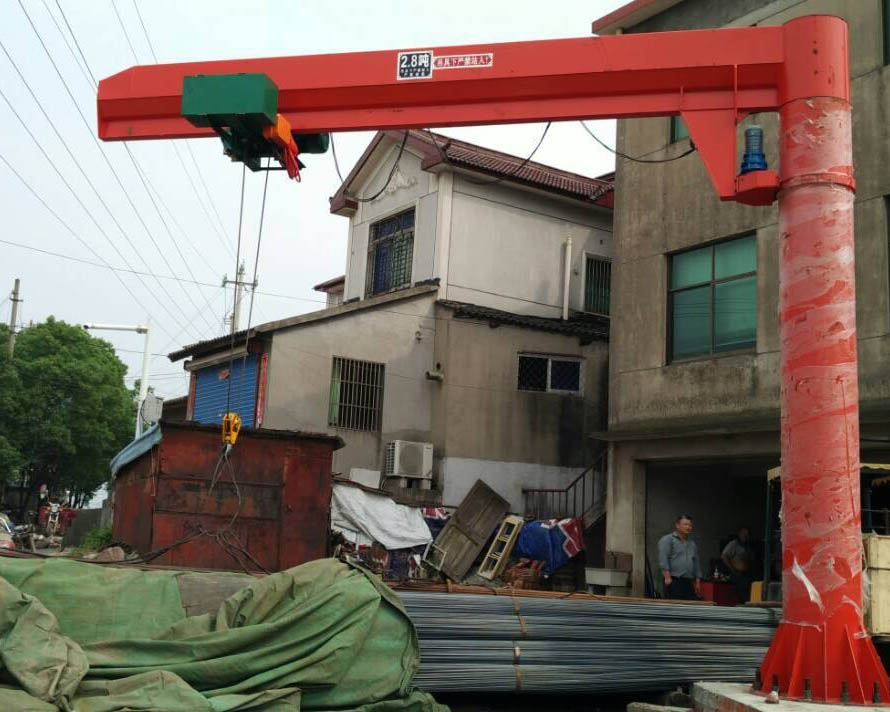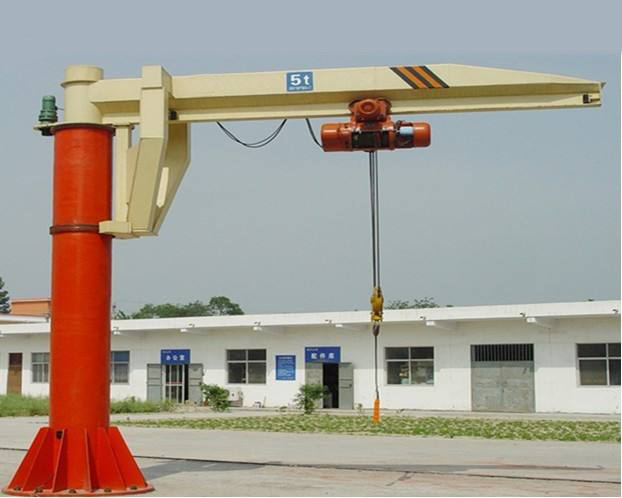For any civil engineering project, cranes are the most important equipment required for the work to be done efficiently. A jib crane is a type of crane, which is most commonly used in civil constructions. The basic function of the cranes is to lift or transfer heavy weighted objects or material. These cranes are differentiated based on their capacity, i.r, the amount of weight they lift, the site of work where they are used, etc. A jib, which is also known as a boom is basically a horizontal member supporting the movable hoist. A drum or a lift-wheel is attached with the help of ropes to lift the weight, using the hoist. the drum is electrically driven and can be manually operated. The jib moves through an arc and helps in lateral movement. The jib cranes are widely used in industries and other civil construction sites.

Design of a jib crane
A jib crane(grua pluma) typically consists of the following components:
- Boom: A boom or a jib is a horizontal beam supporting the hoist, with the help of which the trolley travels.
- Pillar: The mast or pillar is a vertical beam supporting the boom. It is usually free-standing or fixed.
- Movable Hoist: This helps in moving the load.
- Trolley: This carried a hook, chain or wire rope, and the hoist along with the boom. This can be operated manually or electrically or pneumatically.
- Controls: The motorized jib cranes have a push button to control the boom rotation and also the movement of the trolley. They can be operated at different speeds.
- Rotator: A jib can be rotated 360 degrees on a freestanding crane with the help of rotator. The wall mounted(mural) jibs can be rotated about 180-200 degrees.
- Rotation Stop: The rotation stop helps in limiting the crane’s movement in case of any obstruction and keeps it safe from collision with the obstructing object.
Types of Jib Cranes
Jib Cranes usually come in 4 types:
1. Floor Mounted Jib Cranes
These are the most commonly used cranes. They are self-supporting and have a vertical pillar mounted on the foundation. They are operated manually and have 360-degree rotation access.
2. Fixed Wall Mounted Jib Crane
These are horizontally mounted on the wall, with the help of an RCC bracket. The working mechanism is similar to the floor mounted, freestanding jib cranes. The degree of rotation is restricted to 200 degrees.
3. Foundationless Cranes
These are a variation of freestanding jib cranes. They are slab-mounted. They can be operated anywhere and doesn’t require a special foundation.
4. Column Mounted Jib Cranes
These are highly efficient and energy conserving column mounted jib cranes(plumas giratorias de columna). They are used in assembly workshops, heat treatment plants, foundries, etc. They can be controlled by remote control, ensuring easy operation and safety of workers. It has 360-degree rotation access.
Uses of Jib Cranes
- To move or lift heavy objects at construction sites or industries, involving heavy machinery.
- In support of the heavy cranes at construction sites.
- They are useful and easy to operate in a compact space, where it is tough for the regular cranes to operate.
- They are highly accurate and avoids any mishaps during operation.
- The rotation stop avoids it from colliding with any object that obstructs its way.
- They are also used in the military for different purposes.
There are different brands in the market, which manufacture jib cranes at competitive prices. The customer needs to evaluate the features on the equipment, the investment, and estimation of profits they generate. If you don’t know how to choose a jib crane with a competitive price, you may visit the products of aicrane machinery(aicrane maquinaria).

Things that are to be considered while buying Jib Cranes
1. Selecting the right type of jib crane depending on the work type and place. Area of rotation should be considered when working in closed spaces.
2. The overall height of the jib cranes also plays a major role.
3. Different cranes have different power capacities. Depending on the amount of the load to be moved or lifted, high power of low power cranes can be selected.
4. The quality and the durability of the equipment and the aftersales service should be considered.
5. Ease of operation, maintenance cost, and investment cost.
The commercial jib cranes generate good market profits and are in high demand because of the ease of operation, various models suitable for different working conditions(condiciones de trabajo), and their efficiency.